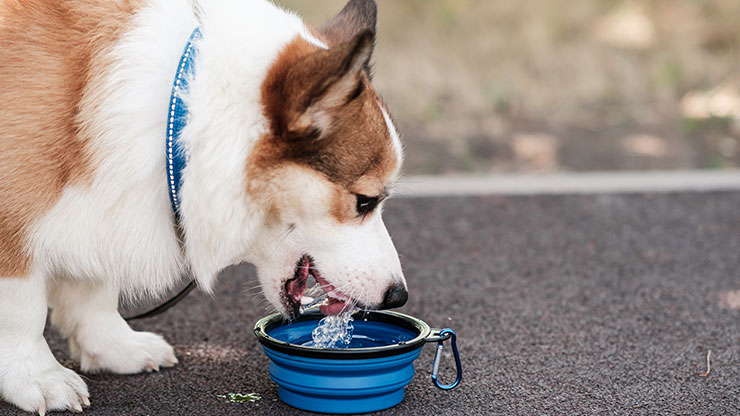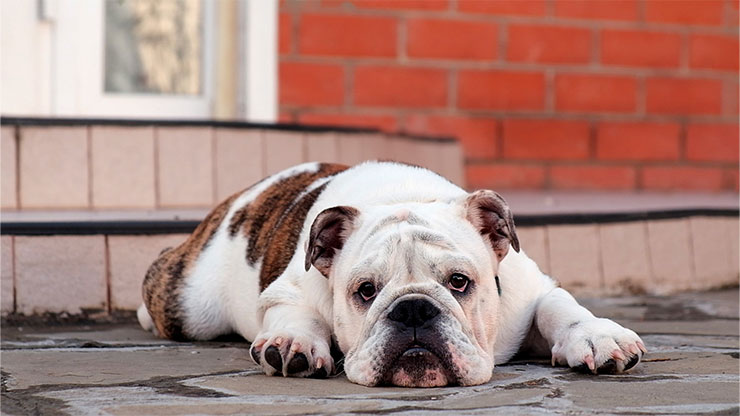
Your Guide to Keeping Dogs Safe in Summer
Who doesn’t like spending time outside with their furry friends? In summer, however, even warm temperatures can lead to overheating in dogs – and it’s your responsibility to ensure they stay healthy and cool enough to play fetch with you. Luckily, it takes a few precautions to keep your dog safe and sound even in a heatwave. Here’s your guide on how to keep your dog cool, how to recognize that your dog may be overheating, and what to do if they show signs of overheating.
When Is It Too Hot to Walk Your Dog?
The best way to ensure your canine doesn’t overheat is by avoiding going outside when it’s too hot. This tip works both for humans and dogs! But what temperature is too hot for dogs? Well, it depends: the reading on a thermometer isn’t the only variable you should consider. That said, what feels like warm spring weather to you may already be hot for your dog. Dogs can start overheating at temperatures of 68°F (20°C). How hot it feels depends on humidity, direct sunlight, and air temperature. Some dogs can weather hot temperatures better than others. For example, those with lighter fur tend to bear the heat better since lighter colors reflect more sunlight. Besides overheating, your canine may burn their paws on hot surfaces. One rule of thumb is to put your palm on the sidewalk yourself. If you can’t keep your palm in place for five seconds, the sidewalk is too hot for your dog. When it’s too hot to walk, go out with your canine early in the morning or late in the evening.
How Long Should Dogs Be Outside in Hot Weather?
It depends on the temperature, humidity, and the dog itself. For example, smaller breeds should only spend 10-15 minutes outside if the temperature exceeds 90°F. However, if it’s too hot for you, try to avoid spending time outside with your dog at all. But if you must venture outdoors during the heat, keep the walk duration to a minimum.

How to Keep Dogs Cool in Summer: Water, Water, Water
The best way to cool off a dog is fresh, cool water. So:
- Make sure your dog has enough water to drink whenever they need. Give your dog water to drink every 15 to 20 minutes when they exercise outside.
- If possible, opt for water activities: a wet dog is a cool one. This can mean playing in a pool or amidst sprinklers or hanging out at a river or a lake.
Can You Give Dogs Ice?
That’s not a good idea. Hard ice can break your canine’s teeth when they chew on it. On top of that, if ice cubes are large, there’s always a risk of your dog choking on one. That said, you can add ice to your dog’s water to keep it cool – just make sure the ice is melted before letting your canine drink.
6 Precautions to Take in Summer
Dogs and heat are a bad combination. Here’s how to keep your pet safe in hot weather:
- Never leave your dog on their own in the car – even if it’s slightly warm outside, even if you’re planning to stop at a store for five minutes. Direct sunlight can heat the interior fast and significantly hotter than the outside temperature.
- Avoid the doghouse. Dogs in hot weather instinctively seek shade, but doghouses are usually poorly ventilated. So, keep your pet inside in a temperature-controlled environment.
- Keep their resting place cool. If their mat is exposed to the sunlight, move it into the shadow. If your place doesn’t have air conditioning, ensure a good airflow over their resting spot.
- Watch out for sunburns. Yes, dogs can get sunburnt in areas with little to no fur, like the bridge of the nose or the belly. Sunburn signs include red or pink skin, dry and cracked skin, and ears curled at the edges. Stay in the shade to prevent sunburns, and consider a pet-safe sunscreen.
- Take breaks. When spending time outdoors with dogs in the summer, watch out for their panting. Don’t push your dog too far with exercising in hot weather and take frequent breaks, especially if they’re panting heavily. Walking dogs in hot weather can have serious consequences for them.
- Have a plan B for electricity blackouts. If you rely on electricity-powered appliances to keep your place cool in summer, consider how you’ll keep your pet fresh if the power ever goes out.

How to Know Your Dog Is Overheating
Dogs in summer can overheat quite easily, all because none of their thermoregulation mechanisms are as efficient as humans. Here are the seven common signs your dog may be overheating:
- Rapid, loud, labored breathing (dogs primarily cool down by panting)
- Temperature over 103°F
- Extreme thirst
- Vomiting
- Changes in the color of gums and tongue
- Heavy drooling
- Sluggishness, fatigue
Note: Elderly and overweight dogs and flat-faced breeds are at a higher risk of overheating. If you suspect your dog is overheating, it is always best to contact your veterinarian or take them there straight away.
In Conclusion: When in Doubt, Talk to Your Vet
Heat-related risks differ from one dog to another. Some breeds have more difficulties regulating their body temperature than others. Additional risks arise if your dog has a preexisting health condition or is simply elderly. So, whenever in doubt, talk to your vet about the best way to counter heat-related risks for your canine friend. And if you suspect your dog is overheating, a visit to the vet should always be in order, too.
-----
Author Bio
Janna Smith is a senior content writer who crafts blog posts and essay pro reviews at NoCramming for students striving to balance studies with other commitments. Before joining NoCramming’s team, Janna built her career in search engine optimization for news outlets and e-commerce websites, leveraging both local and international SEO to boost clients’ visibility.










